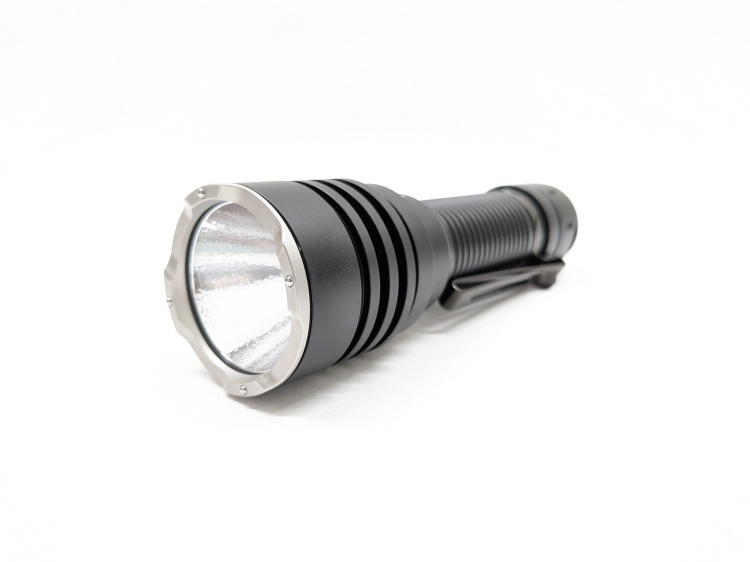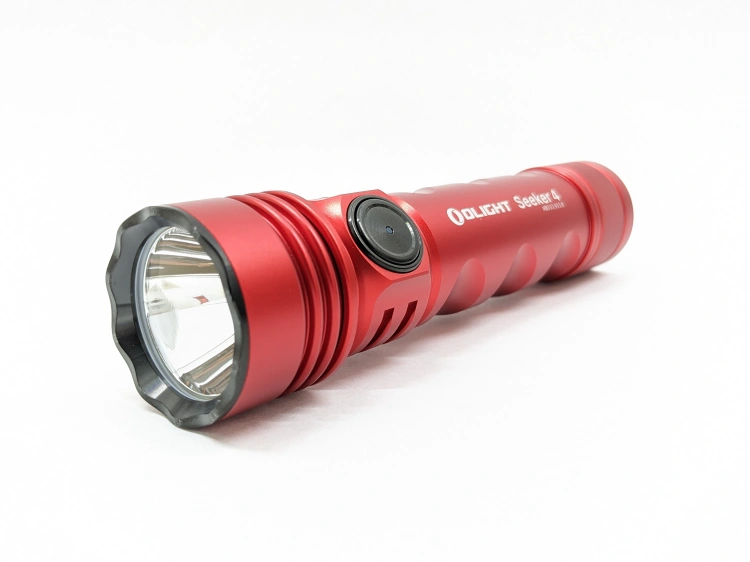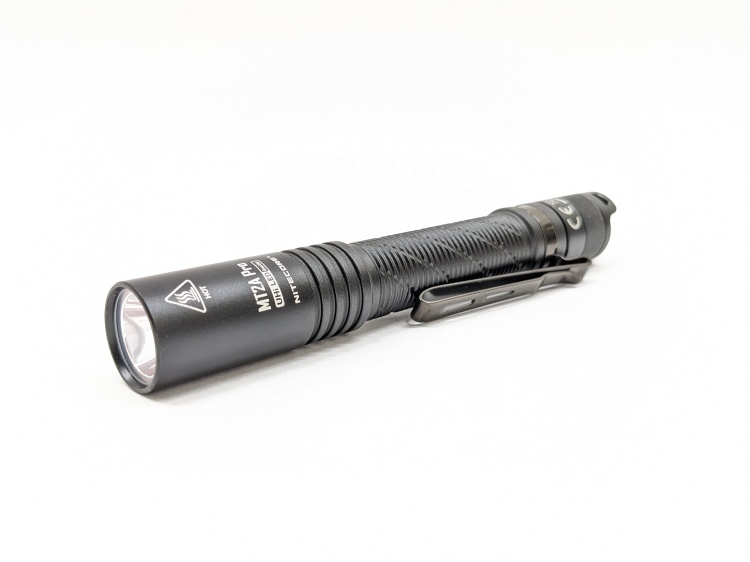Contents
- The Boring Stuff
- What comes in the box?
- Design & Construction
- Size & Measurements
- User Interface
- Modes, Brightness, Throw, & Tint
- Runtime
- Driver & Regulation
- Emitter & Beam
- Switch
- Carry & Ergonomics
- Batteries & Charging
- Competition
- Conclusion
The Boring Stuff
I’ve got three different variants I’m testing in this review that I purchased from Convoy’s official Aliexpress store with my own money.
- Luminus SFT40 with the “ramping” driver
- Nichia 519A with the 5A 12 Group driver
- Osram KW CSLNM1.TG (W1) with the 5A 12 Group driver
If you want to see testing of some C8+’s with colorful LED’s, see this sister review!
What comes in the box?
C8+ comes in Convoy’s cheaper, thin, white, cardboard box with a bubblewrap sleeve protecting the light. It’s bare minimum packaging that keeps the cost down and the only other thing included is a basic lanyard. I discarded the packaging as soon as I opened these, so I don’t have any photos, but here’s the exact same box from my S12 UV review.
Design & Construction
C8+ is an evolution on the venerable and widely used C8 design. There’s a long, narrow body tube that houses the battery and switch with a wide flared head for throw. There are some fins on the head to help keep it cool, and some crenulations in the bezel so you can see when it’s on even when face-down.
Build quality is typical Convoy. It’s not amazing but it’s perfectly satisfactory, especially considering the rock bottom price tag. The threads are trapezoid cut and, as usual, the tail threads are anodized while the head threads are not. I wish the opposite were the case so that adding a collar-style pocket clip were easier. It’s worth noting that the black and brown colored anodizing is more durable than the other available colors.
Size & Measurements
Fireflies E07x Pro | Convoy S12 | Sofirn BLF LT1 Mini | Convoy C8+ | Noctigon KR1

| Measurement | Measured (mm) |
|---|---|
| Bezel Diameter | 44.5 |
| Maximum Head Diameter | 44.5 |
| Length | 142.2 |
| Switch Diameter | 16.0 |
| Lens Diameter | 41.7 |
| Lens Thickness | 1.8 |
| Reflector Hole Diameter | 7.0 |
| Reflector Diameter | 42.5 |
| Reflector Height | 32.5 |
| MCPCB Size | 20 |
| Body Tube Diameter (internal) | 19.0 |
| Body Tube Diameter (maximum) | 25.4 |
| Body Tube Diameter (mode) | 25.4 |
| Body Tube Length | 17.6 |
| Pocket Cip Slot Width | ~3.0 |
| Pocket Clip Slot Diameter | 23.0 |
| Tailcap Diameter | 28.0 |
| Tailcap Length | 28.6 |
| Driver Diameter | 17 |
(I neglected to weigh any of my samples before I glued magnets to the tailcaps)
Weight without battery (with magnet): 151g
Weight with Molicel M35A battery & magnet): 196g
Weight with Molicel M35A battery, FW3A clip, magnet & stainless bezel: 210g
User Interface
Convoy offers several UI’s for C8+ depending on the configuration you order. For more details, see the UI section of my Convoy Guide. For the most part, clicking the tail switch will turn the light on or off, and tapping the tail switch will change modes. Some UI’s have some configuration options too if you want to mess with that.
Modes, Brightness, Throw, & Tint
Disclaimer: Lumen measurements were taken on a Texas Ace 3.5″ Lumen Tube. A candela measurement was taken at 10 meters with an Opple Light Master III on the highest brightness, and other candela figures were calculated relative to that. CRI, CCT, & DUV data was taken for each mode from a few feet away at the center of the hotspot with the Opple Light Master and Waveform DUV Calculator. Runtime tests were performed with the Ceilingbounce app on my smartphone. All of these tests were performed with a fully charged Molicel M35A battery unless otherwise specified. I cannot measure moonlight directly, so moonlight readings are calculated based on the brightness relative to the next-lowest mode. None of this is professional equipment, so take all of these measurements with a grain of salt.
| Level | Lumens (@ Turn-On) | Candela (@ Turn-On) | Throw (meters) | Color temp | Tint (DUV) |
|---|---|---|---|---|---|
| 100% | 1710 | 162000 | 805 | 6720 | 0.0028 |
| 1.5A | 435 | 41211 | 406 | 6160 | 0.0073 |
| 1% | 22 | 2084 | 91 | 5890 | 0.0107 |
| Level | Lumens (@ Turn-On) | Candela (@ Turn-On) | Throw (meters) | Color temp | Tint (DUV) |
|---|---|---|---|---|---|
| Turbo | 1060 | 38000 | 390 | 4700 | -0.0049 |
| High | 480 | 17208 | 262 | 4680 | -0.0001 |
| Medium | 160 | 5736 | 151 | 4470 | -0.0016 |
| Low | 13 | 466 | 43 | 4460 | 0.0000 |
| Moonlight | N/M | N/M | N/M | 4410 | -0.0013 |
| Level | Lumens (@ Turn-On) | Candela (@ Turn-On) | Throw (meters) | Color temp | Tint (DUV) |
|---|---|---|---|---|---|
| Turbo | 900 | 58700 | 485 | 3540 | -0.0032 |
| High | 420 | 27393 | 331 | 3470 | -0.0040 |
| Medium | 140 | 9131 | 191 | 3500 | -0.0038 |
| Low | 10 | 652 | 51 | 3370 | -0.0049 |
| Moonlight | 2.3 | 150 | 1825 | 3330 | -0.0056 |
| Level | Lumens (@ Turn-On) | Candela (@ Turn-On) | Throw (meters) | Color temp | Tint (DUV) |
|---|---|---|---|---|---|
| Turbo | 810 | 230000 | 959 | 6890 | -0.0027 |
| High | 485 | 137716 | 742 | 6490 | 0.0011 |
| Medium | 170 | 48272 | 439 | 6120 | 0.0022 |
| Low | 8 | 2272 | 95 | 5570 | 0.0077 |
| Moonlight | 0.9 | 256 | 32 | 5550 | 0.0076 |
DUV: A negative value is magenta tinted. A positive value is green tinted. +/-0.0010 is not very noticeable. +/-0.0100 is very noticeable.
Mode Spacing: depends on the mode group & emitter you choose. For example, despite using the same driver, my 519A sample and my W1 sample have slightly different mode spacing just because the LED’s have different efficiency curves. To be more specific, the difference between 35% and 100% modes on the W1 version is very small, so small it’s hard to see, and that’s normal.
How does it compare to the official specs? Convoy rarely lists official output specs, and even when they do, they’re just estimates, not measurements. With that said, I noticed there is a candela spec of 140kcd for the CSLNM1 version, which is dramatically incorrect because I measured 230kcd. Perhaps it’s a typo and it was supposed to say 240kcd?
Runtime



LVP: The 12-Group firmware has low voltage warning blinks and an eventual low voltage shutoff. The “Ramping” driver has neither, but it really sips power when the battery is low so you have to leave it on by accident for a loooong time before you’ll discharge the cell to a problematically low voltage.
Thermal regulation: is hit or miss on the 12-Group firmware lights. It exists because I’m able to turn a fan on and the brightness goes up a bit, but it seems to bottom out at 35% mode. Depending on the host & LED, 35% mode might still overheat your light. The “Ramping” UI has no thermal regulation whatsoever, so don’t leave it running unattended.
Driver & Regulation

C8+ has several drivers available, depending on the configuration you buy. Here are the drivers I’ve got in these samples:
- SFT40: “Ramping”: This is a weird driver with a weird UI (that doesn’t “ramp”), no thermal regulation, no low voltage protection, no mode memory, and only slightly more current than the 5A 12-Group driver. I recommend foregoing this driver and choosing the 5A 12-Group driver for use with SFT40 instead. I couldn’t see or hear any PWM. My Opple Light Master picked up some mild flickering on 100% and 1.5A modes, but it wasn’t PWM. It only appears to be regulated on the middle 1.5A mode, which is weird.
- 519A & CSLNM1 (W1): 5A 12-Group Linear. This driver is well suited to these LED’s and comes with a great UI. Regulation is consistent with most other linear drivers: the low-med modes are well regulated but the higher modes are affected by cell voltage. These are constant current drivers and have no PWM whatsoever.



Parasitic Drain: C8+ uses a mechanical switch so there is no parasitic drain unless you have a lighted switch installed.
Emitter & Beam
There are a lot of emitter options for C8+. Check out the C8+ section of my Convoy Guide for a list of options with links to their respective product pages. In this review I’m testing Luminus SFT40, Osram KW CSLNM1.TG (W1), and Nichia 519A.
The LED sits in the bottom of a deep reflector. By default all C8+’s come with a smooth reflector, but you can request an OP one in the order notes or just buy it separately.
CRI (Ra): With my Opple Light Master Pro, I measured SFT40 at 65-70CRI, 519A (dedomed) at 94-97CRI, and W1 at 65-70CRI.




The beam will vary some from emitter to emitter, but C8+ has a fairly large reflector so nonmatter what LED you choose, the beam will be narrow and throwy.






In the beamshots above, the trees where I’m aiming the hotspot are 175M away. In the beamshots below, the park bench where I’m aiming the hotspot is 42M away.







Diffusers: I’d be remiss if I didn’t mention Convoy’s excellent C8+ diffuser. I have one for each of my C8+’s and I get a ton of use out of them. They’re awesome for using the C8+ as a lantern outside, for illuminating a room, or even for doing light painting like these shots below of me running through a field with the Red, Green, and Blue versions.



Switch
C8+ comes stock with a reverse clicky mechanical tail switch. There’s a rubber boot covering the switch and two raised ears on either side to protected it from accidental activation and to allow tailstanding. It’s a fine switch as-is, but it offers a lot of customization options as well if you have a pair of snap ring pliers to take it apart.
- Backlit switches (rubber and metal) for finding the light in the dark
- Colorful switch boots for style
- Forward Clicky Switch for momentary on (requires soldering)
- Ring Magnet to go around the switch and make the tailcap magnetic
- DIY Remote Switch Kit for mounting to a bike or gun (requires soldering)
I opted to install a forward clicky switch (here’s my how-to video) and a ring magnet on all eight of my C8+’s, as well as a body-colored switch boot where I could. I love the forward clickies, but the magnets aren’t strong enough for such a heavy light so I don’t necessarily recommend them. They will only hold the light up on a surface that’s perfectly flat and horizontal.
Carry & Ergonomics
C8+ fits well in the hand. The milling provides plenty of grip without being too aggressive.
The only included carry method is a basic lanyard. It will do the trick, but I’m not really a lanyard guy. There’s a holster for it that works well. It’s really nice with some elastic side pockets and a loop that attaches with velcro and a snap for extra security. This snap-on clip will fit OK. This screw-on clip might fit. If you want a comically large bidirectional clip, Olight Seeker 2’s clip fits pretty perfectly as shown below. None of those clips did it for me…

I opted to install Lumintop FW3A clips on all of my C8+’s (shown below). It worked without any modification on half of them, but the Black, Silver, Green, and Orange body colors required some fitting. Specifically, I carefully sanded the bottom of the tailcap little by little until the light worked properly and it held the clip firmly in place. The clips were very stiff so I bent them all out a little bit too. It’s a pretty big light for a pants pocket but it’s doable. I think these clips add a lot of character.

Tailstand: generally works great. Plenty stable for most applications. If you install a metal lighted switch, the light will not tailstand properly. If you install a forward clicky switch, the light won’t tailstand properly while turned off.
Batteries & Charging

C8+ uses a single 18650 battery. Just about any 18650 will work great as long as it’s not a proprietary or USB-rechargeable one. I used a Molicel M35A for all my testing. If you want a cell included, Convoy usually makes duplicate listings of all their lights that have a battery included, so just poke around on the Aliexpress store for a bit and you’ll probably be able to find the config you want with a battery.
No charging solution is included and I don’t think the cells with built in USB ports will fit. Convoy does sell a few chargers if you need one.
Competition
Here are some lights in the same class and how they compare.
Convoy M1: All the same LED, driver, and switch options as C8+ but with a smaller head. Only available with black anodizing.
Convoy S2+: All the same LED, driver, and switch options as C8+ but in a 1″ tube. It’s available in even more body colors than C8+ and with multiple reflector/optic options to customize the beam.
Noctigon KR1: Smaller, fancier UI, more expensive, most of the same LED options. I reviewed it here.
This section is not comprehensive. If I didn’t include a particular light here, it doesn’t mean it’s bad or doesn’t deserve to be here. I simply cannot list every possible competitor.
Conclusion
C8+ is a stalwart in the Flashlight community because it is so affordable with so many different configurations available. It’s not the light I reach for when I need to see something far away though. That’s usually something smaller and fancier like a KR1 or something much larger and more powerful like an L7.
C8+ is more of a toy for me, and it’s brilliant at that because I can have eight different ones in different body colors with different LED’s without breaking the bank! I can do fun mods like adding a pocket clip, installing a forward clicky switch, or gluing in a magnet without permanently modifying an expensive light. These are just so fun to play and tinker with, so I highly recommend giving one (or several!) a try.






























On the ramping driver, you mention it has no thermal protection, but it clearly steps down very aggressively right after turn on. Unless it’s basically direct drive. But that emitter has a pretty low vf so I would expect it to stay brighter longer. Also the 5a driver doesn’t seem to have very good thermal regulation. Does it heat up that fast to start ramping down so quickly? And I thought it’s supposed to start ramping down at 60c. But from other reviews with temp reading, it starts immediately ramping down before getting hot enough. Is there possibly a timed step down built into these drivers? It seems pointless to run so much current into these lights, if they are just going to step down so quickly
LikeLike
The “ramping” driver on 100% mode runs full-tilt the whole time (with one weird flat spot I can’t explain). There is no thermal regulation at all in that driver. It even said so on the product page at the time of writing this review.
The instant stepdowns in these graphs are caused by some combination of battery voltage sag and/or the emitter and driver heating up I believe. Thermal regulation does not kick in on the 12-group drivers until 1.5-3.5 minutes depending on the LED.
LikeLike
So I have an m21a with 519a 5000k. Basically a c8+ but for 21700 cells. Based on this review. Thanks. This thing is nice! I normally prefer around 4000k but bought 5000k for dedoming. But I’m not sure I want to now. This 5000k is such a perfect white! I’ve got it set in mode 10. I see no need for ml with such a light. So I’m 1%, 10%, 35%, and 100%. I have a really hard time distinguishing between 35% and 100%. Also just installed the orange lighted button. Thanks for the tip on that.
The numbers suggest 100% should be noticeably brighter. How is it on yours?
LikeLike
100% should be noticeably brighter but it probably won’t be a huge difference. It should be very roughly double the lumens from 35%, and double the lumens is not a dramatic change.
LikeLike
Thanks. Ya it’s hard to tell the 150 to 400 jump on my s2+ as well. Oh well guess I’ll just save battery then!
LikeLike